
Quentin Tarantino’s Once Upon a Time In Hollywood opened in North American theaters a couple of weeks ago, but it was just released in my corner of the world yesterday. To commemorate the release of what Tarantino claims is his penultimate feature film as a director, I decided to rewatch and review every full feature film directed by Quentin Tarantino thus far (not including his partially lost amateur film). Below you’ll find reviews of all of the films listed in the image above. So, without further ado, let’s get to it.
Reservoir Dogs – 1992
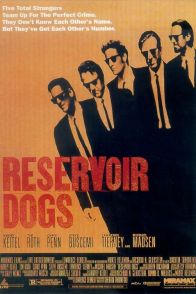
Quentin Tarantino’s Reservoir Dogs is an armed robbery film without the armed robbery in question. Laid out nonlinearly, the crime drama follows six criminals — Mr. White (played by Harvey Keitel), Mr. Blonde (played by Michael Madsen), Mr. Orange (played by Tim Roth), Mr. Pink (played by Steve Buscemi), Mr. Blue (played by Edward Bunker), and Mr. Brown (played by Quentin Tarantino) — in the aftermath of a stick-up-gone-wrong. Waiting at the rendezvous point, the incredulous and concerned Mr. White and the severely wounded ball of stress Mr. Orange are trying to make sense of what happened. As more criminals show up, it becomes clear that one of them is a ‘rat.’
For as long as I can remember, Tarantino has been a name-brand director, but when Reservoir Dogs was released at the Sundance Film Festival a year before I was born, he was just another eager filmmaker — someone hoping to get his foot in the door. Controversial and loquacious, Tarantino tends to ruffle some feathers. He did this first with his violent debut Reservoir Dogs, which supposedly caused mass walkouts upon release at some theaters. It isn’t just that the film is unseemly gory for that time, the film also features many provocative characters that spout offensive language.
Were it not for the flashbacks that his film’s nonlinear structure allows for, Tarantino’s debut would feel very much like a stage play, and the general scarcity of close-up shots in the film’s predominant location supports that claim. The super-wide shots of the film capture the distance and distrust between the many criminal characters effectively, and the character-specific camera work used for Mr. White allows us to fully become involved with his perspective, which allows for the film’s greatest twists, thrills, and moral conundrums.
Roger Ebert, though recognizing the talent of Tarantino, wrote in 1992 that this film was not much more than “an exercise in style.” Ebert wanted more, but even though Tarantino’s debut may be somewhat simple, I don’t think enough praise was given to Tarantino’s distinctive dialogue. Tarantino’s dialogue is darkly humorous and overflowing with pop culture references, albeit references that are dated at this point in time. Tarantino’s stamp is put on cinema for the first time here, and this film is a terrific debut for such an auteurist touch.
The performances in Reservoir Dogs are uniformly strong. Lawrence Tierney is note-perfect as the tough guy mob boss. I especially love Harvey Keitel in this film. Keitel and Tim Roth’s relationship is genuinely touching. Mr. White’s dedication to Roth’s character is the beating heart of the film. Buscemi is delightful, and Michael Madsen’s performance makes Mr. Blonde an intimidating but undeniably electrifying character.
Again, the pop culture references are undeniably dated and the offensive dialogue is unnecessary and gratingly off-putting. I’d also add that I think the flashbacks don’t always work, for me. I think some of them go on for too long, and I would probably say that only Mr. Orange and Mr. Pink’s flashback sequences are necessary. But that is more of a nitpick. Ultimately, Reservoir Dogs, Quentin Tarantino’s directorial debut, is a simple but violent and clever film. It is a gripping crime drama with witty but profanely punchy distinctive dialogue. It might be the most influential directorial debut of the decade, it is one of my favorite directorial debuts of the decade, and it is definitely one of the most rewatchable Tarantino films.
9.5 out of 10
– Jeffrey Rex Bertelsen.
Pulp Fiction – 1994
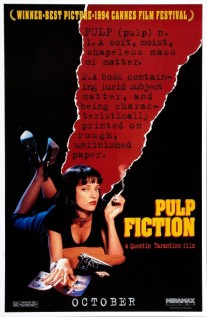
Pulp Fiction is Quentin Tarantino’s most famous film. It made Tarantino an Oscar, BAFTA, and Palme d’Or-winner. If Reservoir Dogs showcased his vision, his touch, and his skill as a filmmaker, then Pulp Fiction was the film that made him a star. And even though I don’t love this film nearly as much as Tarantino’s devoted fans, I can’t deny that it is an outrageously entertaining and impressive sophomore effort. I don’t think it is his best film, but Pulp Fiction is definitely his most iconic film.
Opening with a description of the film’s title, Quentin Tarantino’s sophomore film as a director tells several stories about crime in Los Angeles from the perspective of odd characters. At the heart of the film, we find Jules Winnfield (played by Samuel L. Jackson) and Vincent Vega (played by John Travolta), two hitmen tasked with retrieving a briefcase for their boss, the gangster Marsellus Wallace (played by Ving Rhames). Over the course of the film, Vincent goes through an insane drug-fueled night out with his boss’s wife, Mia Wallace (played by Uma Thurman), and Jules experiences an act of God that stops him in his tracks and changes his worldview. At the same time, an aging boxer named Butch (played by Bruce Willis) wants to change his ways, but, in doing so, he makes an enemy of the wrong man.
I feel like it’s almost a blasphemous act to criticize Pulp Fiction, so let’s get my problems with the film out of the way early. I have a love-hate relationship with the nonlinear structure of this film. On the one hand, I love that the film opens and ends with the diner stick-up. The film is bookended by a terrific sequence with Tim Roth, Amanda Plummer, and Samuel L. Jackson giving top-notch performances, but, in my mind, the sequencing of the different stories in the film isn’t as successful as the film’s acclaim might have you believe. Everything with Travolta, Jackson, and Thurman works as intended. These sequences are incredibly entertaining. But I am much less enthusiastic about ‘The Gold Watch’ and ‘The Bonnie Situation.’ The first hour is so much better than the second hour of Tarantino’s most famous film.
Though I enjoy Christopher Walken’s speech about the history of the watch, I don’t particularly care for Bruce Willis’ character’s journey here. I think it is in this sequence that the film loses more energy than most would care to admit. ‘The Gold Watch’ is overlong and goes places that are random and odd. Though memorable and perhaps iconic, the gimp-scene feels like a completely different film. The Bonnie Situation features characters that I’m more interested in, and the sequence has its moments as a direct result, but it is also a little bit draining. One of the reasons why is that Tarantino’s appearance is jarring and distracting. It simply does not make any sense that Jules would allow Jimmie to talk to him like that. But those are my only issues with a film that I think is still wildly entertaining and effortlessly cool.
The film features the quintessential Samuel L. Jackson performance that has come to define his career going forward. Jackson gives an unblemished, borderline flawless and undeniably iconic performance. The film also resurrected John Travolta’s career based on his performance as one of the Vega brothers, which became Tarantino’s first experience with Tarantinoesque intratextuality, as it were, as he connects the worlds of his own two first films. This is my favorite Travolta-film and role, I realized as I rewatched the film. I think he is paired with these intoxicatingly captivating costars in Jackson and Uma Thurman. Tarantino’s writing in these characters’ conversations is clever, comedic, and, frankly, unforgettable.
Quentin Tarantino’s sophomore film, Pulp Fiction, is often discussed as a true masterpiece, but even though I don’t love it as much as most do, I must admit that it is an undeniably cool and incredibly entertaining film. While I take issue with the structure of the film, it is a hilarious, thrilling, deliciously unforgettable, and inventively well-written crime film.
9.5 out of 10
– Jeffrey Rex Bertelsen.
Jackie Brown – 1997
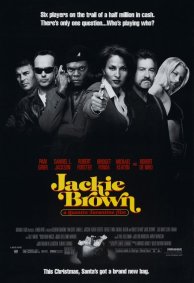
So, when I started writing this list of reviews, I realized that I had actually somehow never seen Jackie Brown, which really excited me. I was now getting to watch an oft-praised Tarantino film for the first time in preparation for a new Tarantino film. That’s exciting. And while I didn’t love Jackie Brown as much as I love his first two films, I quite enjoyed watching this Tarantino blindspot of mine, which, I thought, was both very different from and similar to his filmography in interesting ways.
Based on Elmore Leonard’s Rum Punch and set in the mid-1990s, Quentin Tarantino’s Jackie Brown is a crime film that follows the titular character (played by Pam Grier), a middle-aged African-American flight attendant for a small airline, after she gets caught smuggling money from Mexico and into the United States for the confident but paranoid crime boss Ordell Robbie (played by Samuel L. Jackson). Soon she is a target of the police as well as the paranoid Ordell, so she decides to make the most of the situation and therefore attempts to outwit everyone alongside Max Cherry (played by Robert Forster), a bail bondsman.
After having just rewatched Reservoir Dogs and Pulp Fiction, both of which were made in Tarantino’s distinctive style, the experience of watching Jackie Brown is not unlike that of a palate cleanser. If I hadn’t known this was a Tarantino film when I sat down to watch it — and, of course, if his name wasn’t displayed all over the screen once or twice — I’m not sure I would’ve guessed it if it were not for one Tarantino trademark. It is a crime film with Samuel L. Jackson, smooth needle drops, offensive language, and, of course, the one aforementioned distinctive touch that should inform you of the filmmaker at work, unnecessary lingering shots of a woman’s bare feet.
Tarantino’s third feature film as a director features a uniformly great star-studded cast. And at the heart of the film is Robert Forster’s Max Cherry and Pam Grier’s Jackie Brown whose flirtation and relationship, in general, is delightful to follow. It is probably my favorite Forster performance as he brings charm and kindness to his character, which makes him really compelling. I wish there were more scenes between Forster and Grier, even though I do appreciate Tarantino’s restraint in detailing and describing their relationship. Though it frustrated me that we don’t really get a scene with dialogue with the eponymous character until the half-hour mark, I enjoyed watching Grier in this role. Her character never feels helpless in this film, and I loved that.
Samuel L. Jackson is, obviously, perfect as Ordell Robbie, who he plays as a cheerful, paranoid, and dangerous crime boss who will just as soon shoot you as he may tell a joke. I thought Bridget Fonda gave a quietly confident and strong performance in a role where she got to playfully mess with two of the greatest actors on the planet — Jackson and De Niro. De Niro is underutilized in a, for the most part, fairly dull and bland role. It isn’t a bad performance by any means, but his talents are wasted here.
Here Tarantino has abandoned the non-linear structure of his last two films in favor of a straightforward narrative set in a world that feels more realistic than the world of Pulp Fiction or Reservoir Dogs. It is a well-plotted film with many characters and worlds within full worlds. The dialogue is clever and strong like his first two films, but it doesn’t have these memorably self-absorbed and rambling rant-like discussions that I loved in his previous two crime films. It is nowhere near as self-indulgent (though it is needlessly long), hip, or bloody as Pulp Fiction. Some might say this film showcases a mature version of Tarantino, but I would suggest that this is actually a film where he exhibits self-control and restraint. It is calm, character-focused, and much warmer than anything he had done before. I think I’m going to love and appreciate this film more in a few years. It feels like that kind of film.
8.5 out of 10
– Jeffrey Rex Bertelsen.
Kill Bill, Vol. 1 – 2003
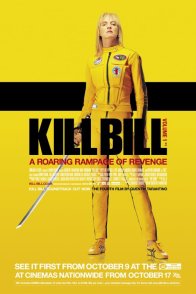
I was listening to a podcast recently, wherein they discussed their first encounters with a Tarantino film. It made me think of the controversial comment Tarantino made at the time Kill Bill, Vol. 1 was released. Some social critics and film critics gave him a hard time for having said that ‘cool parents’ should take their 12-year-olds to see Kill Bill because it would be great entertainment for boys and give ‘a dose of girl power’ to girls. I’ve often watched an old interview on YouTube in which Tarantino is lacerated by a critic for having said this. It goes on for about four or five minutes and it ends with them basically yelling at each other as the critic becomes angry with Tarantino for gleefully defending his comments. She waves at him condescendingly.
What that interview, that comment, and that podcast make me think about is the fact that my first encounter with Tarantino films was with Kill Bill, Vol. 1 when I was, you guessed it, around the age of 11 or 12. My parents certainly hadn’t listened to that interview or those Tarantino comments, but they let me watch it regardless. I’m not saying this to make a point about when you should watch these types of films, but I will say that I loved Kill Bill, Vol. 1 when I first saw it. I had a ‘movie club’ where my friends and I would get together and watch movies, and Kill Bill, Vol. 1 was one of those movies. I loved it, I think I remember us all loving it, and, hey, I turned out all right, didn’t I?
Kill Bill, Vol. 1 is Quentin Tarantino’s attempt to make an American revenge-based action film with stylistic tributes to Asian cinema. A gleeful and gifted pasticheur, Quentin Tarantino split up one exciting revenge-film narrative into two films allegedly because Harvey Weinstein and his associates pressured him into doing so. In this first part of Kill Bill, we are introduced to ‘the Bride’ (played by Uma Thurman), a woman who was severely wounded and put in a comatose state by a group of female assassins and a man known as ‘Bill’ (played by David Carradine). When she wakes up from her coma, the Bride tracks down the female assassins to exact revenge on the deadliest women on the planet.
As indicated above, I think it is fair to say that Quentin Tarantino is perhaps the most unapologetically and shamelessly unoriginal original filmmaker. He embraces his homages and pop culture references. He acknowledges his cinematic borrowings. Tarantino’s Kill Bill, Vol. 1 is a blatant but brilliant pastiche that embraces and appreciates the thematic ties that bind American westerns and Asian cinema together. At this point in his filmography, Tarantino’s fascination with other films should not be a surprise, but Kill Bill, Vol. 1 may be the first time in his career as a writer-director that I think his completed work isn’t much more than an exercise in imitation, homage, and style. With that having been said, it is such an incredibly satisfying exercise.
Tarantino revels in the over-the-top violence, gore, and action of the film. When the Bride repeatedly hits an orderly’s head with a door in the aftermath of the uncomfortable Buck-sequence, you feel every hit, you feel the pressure, and you feel the damage done. When the Bride fights Vivica A. Fox’s character in her home, Tarantino has made sure to exaggerate the sound effects so much so that the result is almost comedic. Whenever katanas are used, the violence that the weapon creates is extremely bloody to an exaggerated degree. There is a precision in every decision made surrounding this film. The costume designs are purposeful, and the locations, lighting, and colors are meant to reference one thing or another.
I love his style in Kill Bill, Vol. 1. I like the use of black-and-white, I think the animated origin story for O-Ren Ishii is terrific, and the entire sequence involving O-Ren Ishii, the Yakuza army, and the Bride in the yellow jumpsuit (which is meant to be a replica of Bruce Lee’s yellow costume from Game of Death) is breathtaking. I never saw this film in the theater, but this sequence alone would be worth the price of admission. It has its funny moments, incredible cinematography, and top-notch action.
As for delicious, memorable, or especially quotable lines, with which Tarantino has made a name for himself, not much can be found in Kill Bill, Vol. 1, though there are one or two memorable lines. In spite of these, Kill Bill, Vol. 1, unlike his first three films, is style over substance. It is a film that contains many terrific action set-pieces, tributes, and beautifully designed locations. But it doesn’t contain the delicious dialogue, deep characters (we have the vengeful bride but that’s pretty much it), or a complete plot (Yes, it is only one half of a two-part story, but it doesn’t stand alone like other first parts do).
“This is what you get for fucking around with Yakuzas! Go home to your mother!”
Taste changes over time. You don’t necessarily love something now that you loved as a child. You may have grown out of something. You may have matured. Quentin Tarantino’s Kill Bill, Vol. 1 was my favorite film of its kind for a long time in my teenage years. And yet, I hadn’t seen this film in maybe ten or twelve years, so I was interested in figuring out how the film felt and played to me now. Having just rewatched it, I must admit that it is nowhere near as outstanding and flawless as I had read it or perceived it to be when I was younger. Having said that, though, I still think this is a film that contains some of my absolute favorite action set pieces of all-time.
He may steal from other films, but the O-Ren Ishii showdown is still an incredible showstopper. It’s a jaw-dropping guitar solo in the form of an over-the-top action sequence. It’s as captivating as any line of dialogue he has ever written. All in all, though Kill Bill, Vol. 1 isn’t as flawless as I had remembered it being, I still love this cinematic love letter in the form of a martial arts, samurai revenge tale. It is a wake-up call for critics who thought Jackie Brown had proved that Tarantino had matured as a filmmaker, and it is a stupendous crowdpleaser for devoted fans of his.
8.3 out of 10
– Jeffrey Rex Bertelsen.
Kill Bill, Vol. 2 – 2004
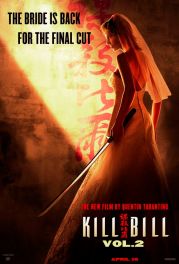
If you’ve been reading my reviews of both volumes of Kill Bill back-to-back, and if you’ve been paying attention, you may have noticed how I said that Kill Bill, Vol. 1 was a personal favorite of mine for a while, but that I, having said that, still hadn’t rewatched it in about ten years or so. You see, I really didn’t like Kill Bill, Vol. 2 when I first saw it. I’m honestly not sure if I ever finished watching it back then. I really didn’t like Volume Two, and it, frankly, soured me on the entire story. Having finally rewatched it for the purpose of writing this review, I must say that it, by no means, is as horrendous a film as I once must’ve thought it was. But I still think it is a serious step down from the highs of Volume One. In fact, I had to rewatch it over the course of two or three days, because it constantly put me to sleep.
The second volume of Quentin Tarantino’s Kill Bill still follows the Bride (played by Uma Thurman) as she hunts down those who tried to kill her at her wedding rehearsal. This time around, after having finished off O-Ren Ishii and Vernita Green, the Bride has her eyes on the weary former assassin Budd (played by Michael Madsen), and the driven one-eyed female assassin Elle Driver (played by Daryl Hannah). If she wants to actually kill Bill (played by David Carradine), she first has to cross off those two names on her list.
Kill Bill, Vol. 2 is wordier than the first film but also much more long-winded. Though Kill Bill, Vol. 1 did feel like an episodic genre mash-up, it was a fast-paced and wildly entertaining first film. In my review of Kill Bill, Vol. 1 I noted that the dialogue was not up to the standard expected of a Tarantino film, and, even though this film is a longer and wordier film, the same can be said for Kill Bill, Vol. 2. David Carradine, who, by the way, is perfectly warm when he needs to be and appropriately venomous and cold when the script asks it of him, does his best with a maddening monologue about comic books that is more irksome than entertaining. I think Uma Thurman plays the nerves and tension of the wedding rehearsal extremely well, but there were, admittedly, moments later in the film that I simply didn’t believe.
The runtime is self-indulgent and excessive. This film simply does not need to be 136 minutes long, and you can tell it quite easily. It is a really slow film with scenes that go on for too long or should’ve probably been left on the cutting room floor. But the film does, admittedly, have its moments of brilliance. There is a graveyard sequence that was both really entertaining and a very good pay-off. The fight between Elle Driver and the Bride is somewhat clever, and some of the pop culture references are pretty neat. There are moments towards the end of the film, where the film becomes quite sweet in spite of the obvious tension between Bill and the Bride, that I thought were excellent. The first film ended on a cliffhanger that teased motherhood, and I really liked some of the scenes that dealt with that theme.
Kill Bill, Vol. 2 isn’t a bad movie, but it might be the Tarantino film that I dislike the most. Again, this movie has its moments, but the pacing and rhythm of Kill Bill, Vol. 2 is unlike the pacing of the first volume. It is nowhere near as intense or satisfying as the first film. It remains a huge disappointment to me that Quentin Tarantino’s Kill Bill, Vol. 2 is a self-indulgent, unexciting, clumsy, and forgettable sequel to a film that I still enjoy quite a bit.
6 out of 10
– Jeffrey Rex Bertelsen.
Death Proof – 2007

It’s a little bit funny that this is both the first Quentin Tarantino film that I saw in a movie theater but also the film of his of which I have the worst memory. I don’t remember it well. Death Proof was released in America as a Grindhouse-double feature with Robert Rodriquez’ Planet Terror but separately internationally, which is why I actually still haven’t seen Rodriquez’ film. In any case, I was excited to revisit a film that I didn’t have a strong memory of. It pleased me to find out that, even though it is a rough and frustrating film in moments, the second half of Death Proof is a really entertaining revenge-focused B-movie with three female leads having the time of their lives.
Quentin Tarantino’s Death Proof is a story about a vicious murderer, Stuntman Mike (played by Kurt Russell), who uses his vehicle, his ‘death proof’ stunt car, to kill civilians on the road. In the first half of the film, we are introduced to Stuntman Mike and his first victims, who are all female. He enjoys toying with them and he wears a cheeky grin as he, eventually, reveals his true intentions. The second half of the film is devoted to introducing the friendship that the film’s true protagonists have. The film puts a group of female friends, led by real-life stuntwoman Zoë Bell (playing herself), against Stuntman Mike, and the outcome is surprisingly delightful. It is probably Tarantino’s most insignificant film, but I do not think it is Tarantino’s worst film like he has previously argued.
That having been said, his early attempts to pay respect to, reference, or satirize exploitation slashers or old B-films he may have seen at a theater he snuck into when he was young did not work for me whatsoever. Tarantino went for an aged, blemished, grainy, and, frankly, ugly look, and, of course, there are frames missing here and there. It is a decent or neat idea but in practice it is jarring. If it was an attempt by Tarantino to give young audiences a history lesson, then I think this was the wrong way to do it. It’s an admirable attempt, I suppose, but that is the best thing I can say about it. Some might call it a noble misstep, but I would rather identify it as an obnoxiously self-indulgent exercise. This, however, only provides my opinion on the first half of the film which, other than being a stylistic misstep also includes these overlong bar-scenes.
The second half of Death Proof is a delightful revenge road-thriller. The visual look is completely different from the first half of the film. First, we have a scene or two in delicious black-and-white, and then the rest of the movie is in color as Tarantino gives his modern twist on the films he intended to pay homage to. I greatly enjoyed these characters’ conversations. They were witty and kept my attention, which is something that I could not say about the characters or their conversations in the first half of the film. The ‘duel’ between the two muscle cars towards the end of the film is genuinely thrilling and the ending to the film is an incredibly satisfying punchline that is worth the experience of watching the first half of the film, even when the camera gazes at women’s backsides for uncomfortable periods.
Having rewatched it, I definitely understand why some critics really enjoy Death Proof. Though the first half of the film is obnoxiously self-indulgent, the second half of the film removes the blemishes of the first half and becomes quite satisfying. Death Proof isn’t Quentin Tarantino’s worst film, even though he may beg to differ.
7.2 out of 10
– Jeffrey Rex Bertelsen.
Inglourious Basterds – 2009
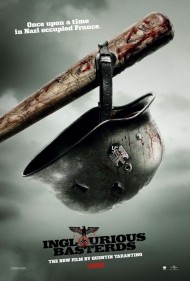
Quentin Tarantino’s war film had been in some kind of development for about a decade when it was finally released. Tarantino referred to it as ‘the best thing he had ever written,’ and he, supposedly, had difficulties with the ending. Over the years, Tarantino films would come out to varying success, but Tarantino was always in the back of his mind finalizing his war film. If at this point in time Quentin Tarantino was in need of a return to form, then Inglourious Basterds was his return to form.
Quentin Tarantino’s Inglourious Basterds is the American auteur’s World War II-film, which gave Tarantino the opportunity to employ his style to a genre of film that was unlike anything he had done before. What is unique about Basterds is the fact that it is a revisionist, alternate universe approach to real-life history. It is not only one of his funniest films but also, in my mind, his very best.
“I think this just might be my masterpiece.”
Tarantino’s film primarily follows two different characters. First, the film follows Lt. Aldo Raine (played by Brad Pitt) of the infamous ‘Basterds,’ a militia of Jewish-American soldiers whose reputation precedes them and frightens German Nazi soldiers. Finally, the film follows Shosanna (played by Mélanie Laurent), a Jewish woman who has gone into hiding after having survived an attack by SS colonel Hans Landa (played by Christoph Waltz) and his firing squad in 1941. In Inglourious Basterds, both parties are being searched for by Landa, while they try to accomplish their missions of eliminating Nazi soldiers.
Inglourious Basterds is Quentin Tarantino at his peak. It is him, his style, writing, and direction at its very best, in my mind. From the moment it begins until the moment the film gleefully sends you out of the movie and on your way home, Tarantino holds you in the palm of his hand and gives you a thrilling, often uproarious and tense alternate history film. The dialogue is masterful, the writing is clever and witty, and whenever we switch from language to language it seems purposeful. The performances are outstanding and the characters are memorable.
The opening scene in 1941 between Landa and LaPadite (played by Denis Ménochet) is unforgettable. It is tense, it is loaded, but the moment Landa pulls out his pipe it becomes momentarily hilarious. Of course, Landa then makes it even more serious and the scene doesn’t lose its power. It’s the scene that deservedly earned Christoph Waltz an Oscar. Brad Pitt later gives it his all as the leader of the Basterds, a cartoonish American caricature, and he plays him absolutely perfectly. I’ll always remember his performance for the character’s attempt at an Italian accent.
Shosanna is a captivating heroine and played wonderfully by Laurent, with her standout scene obviously being the one wherein Landa interrogates her. Daniel Brühl’s Zoller is another really well-written character. He’s outwardly friendly and charming at first. But he’s a Nazi, and he reveals himself to be consumed by the ideology, he’s a symbol of the ideology, and he’s an incredibly entitled male character who feels cheated when Shosanna doesn’t just fall for him.
Of course, Tarantino also brought audiences’ attention to Michael Fassbender, who’s delightful, engrossing, and paranoid as my favorite film critic character that I’ve ever seen in a film. Furthermore, August Diehl is quietly amazing and bold as Major Hellstrom. I could go on and on, even the actor playing Hitler (Martin Wuttke) is perfect for this film.
Just like how, at the end of the film, the German’s gather to watch, be excited, and laugh at the violence of a pro-Nazi propaganda film ‘Stolz der Nation,’ when the film reveals itself for all to see that it is an alternate history film, it does so with a furious glee as characters shoot down individuals who were not shot or killed at that point in time in history. This is a wish-fulfillment revenge fantasy. Tarantino has fun with it because that is exactly the kind of person he is. A different filmmaker may have removed the Basterds and focused on Shosanna, and maybe it would have made for a moving and strong picture, but this is a Quentin Tarantino film and it includes all of the things that his fans love him for, and it, notably, doesn’t include the one thing that I am generally bothered by with his films: the nonlinearity of it all. Sure, there are flashbacks, but, for the most part, it moves along in chronological order.
I think that, in spite of its length, this is easily Tarantino’s most rewatchable film. Again, it contains all of the elements that people love Tarantino for, such as pop culture references of varying depth, style, extreme violence, tension-filled scenes, memorable characters, clever dialogue, and undeniably and satisfyingly humorous moments in otherwise serious scenes, but it doesn’t have the sometimes impractically nonlinear structure of his earlier work. This isn’t just an exercise in style, violence, or genre. Like Brad Pitt’s character suggests at one point, this is a masterpiece.
10 out of 10
– Jeffrey Rex Bertelsen.
Django Unchained – 2012
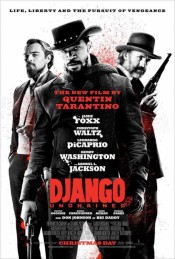
Set in the American South of the late 1850s, Quentin Tarantino’s Django Unchained follows a German dentist-turned-bounty hunter, Dr. King Schultz (played by Christoph Waltz), as he tries to figure out where the infamous Brittle brothers are. Django (played by Jamie Foxx), a shackled slave, holds the information the German needs, so Schultz buys and frees Django, but not before he has already shot the men who shackled him. Together Schultz and Django start to collect bounties on wanted men. They become quite a good team, but there eventually comes a time when Django needs Schultz’s help. Django desperately wants to free his wife, Broomhilda von Shaft (played by Kerry Washington), but they discover that she is held at the so-called Candyland whose ownership is infamously cruel to their slaves. Django and Schultz devise a plan to fool the plantation owner into freeing Broomhilda, but that is a mission easier planned than accomplished because plantation owner Calvin J. Candie (played by Leonardo DiCaprio) and his trusted and loyal house slave Stephen (played by Samuel L. Jackson) are not easily fooled.
Django Unchained grabs you and pulls you in from the very first moments of the film and holds you firmly for quite some time, but I wish I could say it never let go. Sadly, Tarantino exhibits absolutely no self-control here. Tarantino’s film is at least thirty minutes too long. Tarantino’s own appearance in the film is incredibly distracting as he puts on a foreign accent that I don’t think he masters. The first hour of the film is splendid, but, right around the first hour-mark, the film starts to sag slightly. I think there are more scenes here that could’ve gotten the montage treatment. At one point late in the film following an explosive shootout, the film felt endless and that isn’t a compliment. But although I do think this film is seriously overlong, I really do enjoy it.
I was reminded of my love for Django Unchained almost immediately. The unoriginal theme song is bombastic and so perfect for the film. The sequence in which Django is freed is terrific and the subsequent sequence in the local town are such great moments in which Christoph Waltz shows off just how perfect he is for Tarantino’s material yet again. Here Waltz is less menacing than in Inglourious Basterds, but, arguably, just as good. Although he’s not as menacing and still very polite, he is incredibly dangerous and unpredictable. The music is glorious and sometimes spine-tingling. I especially love the shot where the music soars slowly as Django is standing there in his blue outfit in a wide shot right before he murders the Brittle brothers, and I also love the moment Django throws off the blanket from off his shoulders in slow-motion as he is freed.
Like he is known to do, Tarantino here put another spin on well-trodden genres. Django Unchained is a pastiche of blaxploitation and spaghetti western films. Like he is known to do, he has multiple pop culture references, and this time around he also includes a cameo that is impossible to miss. The blood sprays violently as if someone had tripped with a saucepan and spilled tomato sauce all over the set. At one point, a woman flies backward from a gunshot at an angle which would make that quite impossible. It is exaggerated, and, if you’ve seen the Kill Bill films, then you know he loves that.
Django Unchained received a lot of deserved awards and award nominations, but I think it is a crime that the Academy of Motion Picture Arts and Sciences didn’t find room to give Jamie Foxx a deserved nomination for the category ‘best actor.’ Foxx is electric and cool, but there is more to his performance than just that. It is a performance worthy of high praise and multiple accolades. Of course, the same can be said for the intense but sometimes comedic performance given by Leonardo DiCaprio, or the unforgettable performance given by Samuel L. Jackson, who, finally, plays a completely different character than the type of character he is known for playing in Tarantino films. Thankfully, the AMPAS did give the Oscar for ‘best supporting actor’ to Waltz for his second outstanding performance in a Tarantino film. In Waltz, Tarantino has found someone who, like Jackson, speaks Tarantinoesque dialogue better than most.
When I sat down to rewatch Quentin Tarantino’s Django Unchained, his first attempt at a western, I was honestly a little bit trepidacious. I was pretty sure I had enjoyed the movie back when I first saw it, but now I mostly just remembered the controversy and not much else. So it pleased me greatly to able to say that I still think Django Unchained is an incredibly entertaining and well-made western from top to bottom, even though there are a couple of times when it feels like Tarantino didn’t know when to rein himself and his story in.
8.5 out of 10
– Jeffrey Rex Bertelsen.
The Hateful Eight – 2015
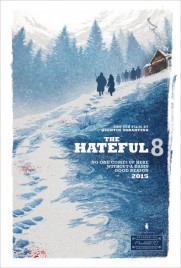
There is a lot to like about The Hateful Eight, but, honestly, this was the rewatch I was dreading the most. I remember respecting The Hateful Eight more than I liked it when I first saw it. Having now rewatched it, I can confidently say that I still haven’t warmed to the film, even though I certainly do understand the appeal of it. I like it more in theory than in practice, if that makes any sense.
Quentin Tarantino’s The Hateful Eight is a bloody western chamber piece. The film follows bounty hunters John Ruth (played by Kurt Russell) and Marquis Warren (played by Samuel L. Jackson), as well as fugitive Daisy Domergue (played by Jennifer Jason Leigh), as they seek refuge from a blizzard at Minnie’s Haberdashery. But the strangers at the lodge are suspicious and the owner of the haberdashery is nowhere to be found. The bounty hunters may have walked into a trap.
With The Hateful Eight, Tarantino essentially tried to take the best of three of his most popular films and make it into a new film, which would probably make for a pretty great play. Tarantino tried to recapture the incredible tension of Inglourious Basterds‘ best scenes, he took the single location stranger mystery of Reservoir Dogs, and then he wanted to make another western now that he had mastered the look of a modern and expensive Hollywood-produced western in Django Unchained.
The Hateful Eight features incredible cinematography and production design. The production and costume designs perfectly create the world and the characters. Tarantino’s film has some gripping sequences including but not limited to Warren’s story about General Smithers’ son. Jennifer Jason Leigh, Samuel L. Jackson, and Walton Goggins all give some really memorable performances. But, as I rewatched the film, none of the characters held my attention or captured my interest for particularly long. If you don’t care about the characters, it is difficult to feel the tension, which Tarantino never uses as effectively as he did in Inglourious Basterds, or the mystery itself. I also think that the film makes you numb to the gruesome and ugly violence, and, eventually, you become weary of it.
As I have made clear in previous reviews of his films, I am not necessarily a fan of Tarantino’s use of a nonlinear structure. In The Hateful Eight, there are multiple chapters that reveal some previously unknown twist by backtracking and retelling the scenes that you have just seen from a different perspective or in a different context. This might’ve worked better for me were it not for the fact that it is needlessly long.
Though I will say that it is a theatrical experience, and watching it at home robs the film of its full effect (however, all of his other films work at home, this one should too). Quentin Tarantino’s The Hateful Eight is a three hour, self-indulgent and plodding chamber piece western that has its moments of greatness, but which is also, in my mind, a serious step back for the seasoned writer-director.
6.9 out of 10
– Jeffrey Rex Bertelsen.
